After Christmas, you can’t pass through a Japanese supermarket without seeing a pile of bags of rice cakes aka Mochi in Japanese. It plays a significant role in Japanese New Year, and appears almost daily on the dining tables at Japanese households during the following months. Like any other food, the manners of enjoying these white blocks of rice vary greatly by region across the country, but here we will introduce the basic of basic in cooking Mochi.
Table of Contents
What is Mochi?
Before going on, here’s an explanation of what Mochi (餅) is. The ingredient for the most standard white Mochi is a kind of rice called Mochigome, which is stickier as compared to the kind eaten for daily meals. Instead of being cooked in the same way as regular rice, Mochigome is steamed. Steamed Mochigome is then pounded while it’s hot. By pounding, Mochigome increases viscosity and the soft glutinous mass becomes smoothened. Traditionally, this process is done by two persons using a huge wooden mortar and mallet, but nowadays there are Mochi making machines for home use. Before the mass cools and hardens, it is formed into smaller pieces. It can be rounded by hand, or flattened and then cut into square pieces. Freshly made Mochi is warm, soft, stretchy and has the sweetness of rice, and dried ones are preservable over some time.
Baking Mochi
Baking is the most common method of cooking Mochi. You can do this easily at home, using a toaster oven, the gas stove grill in your kitchen, a frying pan, or do it in the traditional style with a “Shichirin” (charcoal stove).
Using a toaster oven
If you own one, a toaster oven is probably the easiest and fastest of all because the heat surrounds the Mochi and all you need to be careful is not to burn it.
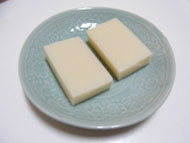
1. Start
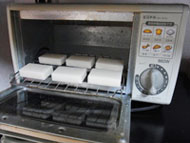
2. Lay it in the toaster.
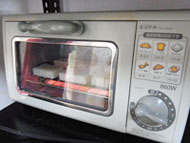
3. Set to about 5 minutes.
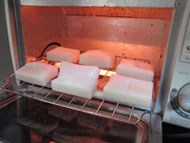
4. After a while it starts to puff.
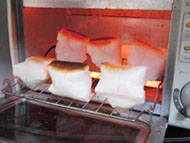
5. Let it puff and get lightly browned.
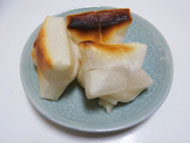
6. Done!
Using the gas stove grill
Japanese gas stoves (gas cooktops) often have a small drawer which is a grill. In this type of grill, the food is cooked below the flame.
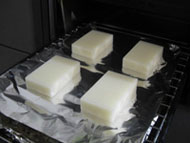
1. Lay the Mochi on aluminum foil, close the drawer and turn on the heat.
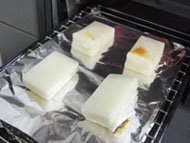
2. Since the heat only comes from above, it’s better to turn it over when the top side is toasted.

3. Bake the other side until puffy and browned.
Using a frying pan
If you use a non-stick frying pan you can bake Mochi without getting the pan sticky. You can also lay baking sheet on top of the pan before putting the Mochi, or alternatively use a drop of vegetable oil if you’re worried.
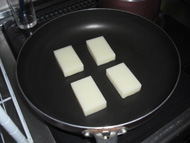
1. Heat the pan and bake the Mochi over medium heat.
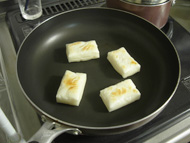
2. Turn it over when the bottom side is puffed and brown. Repeat this process if necessary.
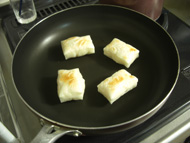
3. Wait till the whole Moch is puffed.
Using a Shichirin (or charcoal grill)
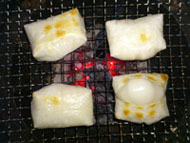 A Shichirin (七輪) is a small Japanese charcoal stove. Shaped like a large bowl it is easy to move around, and can be found in old Japanese houses. While it’s rather a rarity and by no means the most convenient cooking tool today, you may want to try it if you see one because the effects and flavor charcoal heat cooking gives to the foods is incomparable. The method is basically the same as using a frying pan, and is a little faster.
A Shichirin (七輪) is a small Japanese charcoal stove. Shaped like a large bowl it is easy to move around, and can be found in old Japanese houses. While it’s rather a rarity and by no means the most convenient cooking tool today, you may want to try it if you see one because the effects and flavor charcoal heat cooking gives to the foods is incomparable. The method is basically the same as using a frying pan, and is a little faster.
Baked Mochi can be enjoyed in any flavor you like. The most standard Japanese ways are to put plain soy sauce, eat with Anko (あんこ, sweet red bean paste), or with Kinako (きな粉, soy powder sometimes with sugar), but there are dozens of varieties. Because Mochi itself doesn’t have strong flavor (afterall it’s 100% rice), you can try with other tastes too, like cheese, bacon, garlic, or if you like it sweet, honey or jam.
Using a Microwave
Using the microwave is the fastest way to cook Mochi. All you have to do is to wet the surface of the Mochi, put it on a microwavable dish, cover with plastic wrap, and heat it for about 1 minute (500W). Instead of water, you can lay a piece of baking sheet, Nori (seaweed) or Kinako (soy powder) underneath the Mochi to prevent from sticking to the dish.
The time depends on the microwave you’re using, the wattage, and the number of Mochi you’re heating at once. Be careful not to overdo it – it will literally explode and melt. If you’re worried, check every 30 seconds to make it to your preference.
Mochi cooked using a microwave is soft and stretchy, but does not have the crispness of the baked Mochi.
Boiling Mochi
Boiled Mochi is used in dishes like Ozoni (お雑煮, a kind of New Year's dish) or Oshiruko/Zenzai (with sweet red bean paste). The use is not limited to these dishes, and recently varieties in Chinese or Korean tastes as well as western tastes are enjoyed among Japanese people. To boil Mochi, lay it in a saucepan, put cold water so that it completely covers the Mochi (deeper the better) and turn on the heat. Gently move around the Mochi so that it doesn’t stick to the pan. Once the water comes to a boil, turn the heat to low and let it simmer for a couple of minutes. Take it out when it’s soft and before the surface starts to melt.
How to Preserve
Dried Mochi can be preserved for a few days at normal temperature during Japanese winter, but can get moldy if left out for too long. If you don’t have too many and can finish it in a short time, just keeping it in the refrigerator will be enough. Bags of individually packed Mochi (Kirimochi) often have instructions on the back side on how to cook & preserve. If you can read Japanese or get help from a Japanese person, it is the best to follow the instructions on the bag.
If the amount is more than you can consume in a couple of weeks, freezing is recommended. To freeze Mochi, first wrap each Mochi tightly with plastic, put a few of them in a resealable storage bag, and put it in the freezer. Frozen Mochi can be preserved for as long as a year, but can lose flavor and may get freezer burn over time.
To cook with a microwave, take away the plastic and do it the same way as regular unfrozen Mochi. To bake it, first put it in the microwave for about 30 seconds, and then bake it in the method of your choice.
Mochi Varieties: Flavors and Servings
 The very basic Mochi is white, but there are a few colored variations.
The very basic Mochi is white, but there are a few colored variations.
The most common are green and yellow, and they are both colored with natural ingredients. Green Mochi is colored with a kind of herb called Yomogi (よもぎ, mugwort). It is commonly called Kusamochi (草餅) which is commonly seen at stores throughout the year. Yellow uses Kuchinashi (くちなし, gardenia berry) and unlike Kusamochi it is tasteless. Kuchinashi is also used for red (pink) ones. Some other kinds include Mochi with black sesame, seaweed, black soy beans, and so on. Variations are almost uncountable as different kinds develop in different parts of the country.
As mentioned in the previous page, Mochi can be enjoyed in many ways. Below are some samples.
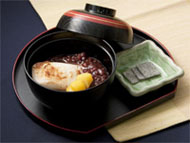
Oshiruko (alt. Zenzai): Mochi in a soup
of sweet red bean paste
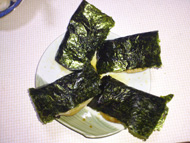
Isobeyaki: With soy sauce and wrapped with seaweed
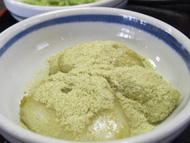
Kinakomochi: Topped with dry soy bean powder

[…] in the kitchen and opportunities to try it in a spectrum of sweet and savory dishes. The ingredient can be baked, fried, boiled and grilled, and in addition to its more traditional uses, innovators like Shyu and Butarbutar are using it in […]